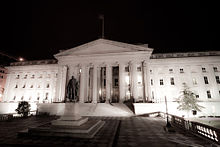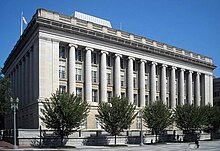United States Department of the Treasury
From Wikipedia, the free encyclopedia
"OFR" redirects here. For other uses, see OFR (disambiguation).

| |

| |
 | |
| Agency overview | |
|---|---|
| Formed | September 2, 1789 |
| Preceding agency |
|
| Jurisdiction | Federal government of the United States |
| Headquarters | Treasury Building 1500 Pennsylvania Avenue,NW Washington, D.C. 38°53′54″N 77°2′3″W |
| Employees | 115,897 (2007) |
| Annual budget | $14 billion (2013) PDF |
| Agency executives | |
| Child agencies | |
| Website | treasury.gov |
The Department of the Treasury (DoT) is an executive department and the treasury of the United States federal government. It was established by an Act of Congress in 1789 to manage government revenue.[1] The Department is administered by the Secretary of the Treasury, who is a member of the Cabinet. Jacob J. Lew is the current Secretary of the Treasury; he was sworn in on February 28, 2013.
The first Secretary of the Treasury was Alexander Hamilton, who was sworn into office on September 11, 1789. Hamilton was asked by President George Washington to serve after first having asked Robert Morris (who declined, recommending Hamilton instead). Hamilton almost single-handedly worked out the nation's early financial system, and for several years was a major presence in Washington's administration as well. His portrait is on the obverse of the U.S. ten-dollar bill while the Treasury Department building is shown on the reverse.
Besides the Secretary, one of the best-known Treasury officials is the Treasurer of the United States whose signature, along with the Treasury Secretary's, appears on all Federal Reserve notes.
The Treasury prints and mints all paper currency and coins in circulation through the Bureau of Engraving and Printing and the United States Mint. The Department also collects all federal taxes through the Internal Revenue Service, and manages U.S. government debt instruments.
Contents
[hide]History[edit]
The establishing act of congress passed in 1789, read in part,
President George Washington appointed Alexander Hamilton as the first United States Secretary of the Treasury on September 11, 1789. He left office on the last day of January 1795. Much of the structure of the government of the United States was worked out in those five years, beginning with the structure and function of the cabinet itself.
In the next two years, Hamilton submitted five reports:
- First Report on the Public Credit: Communicated to the House of Representatives, January 14, 1790.
- Operations of the Act Laying Duties on Imports: Communicated to the House of Representatives, April 23, 1790.
- Second Report on Public Credit – Report on a National Bank. Communicated to the House of Representatives, December 14, 1790.
- Report on the Establishment of a Mint: Communicated to the House of Representatives, January 28, 1791.
- Report on Manufactures: Communicated to the House of Representatives, December 5, 1791.
2003 reorganization[edit]
Congress transferred several agencies that had previously been under the aegis of the Treasury department to other departments as a consequence of the September 11, 2001 terrorist attacks. Effective January 24, 2003, theBureau of Alcohol, Tobacco and Firearms (ATF), which had been a bureau of the Department since 1972, was extensively reorganized under the provisions of the Homeland Security Act of 2002. The law enforcementfunctions of ATF, including the regulation of legitimate traffic in firearms and explosives, were transferred to the Department of Justice as the Bureau of Alcohol, Tobacco, Firearms, and Explosives (BATFE). The regulatory and tax collection functions of ATF related to legitimate traffic in alcohol and tobacco remained with the Treasury at its new Alcohol and Tobacco Tax and Trade Bureau (TTB).
Effective March 1, 2003, the Federal Law Enforcement Training Center, the United States Customs Service, and the United States Secret Service were transferred to the newly created Department of Homeland Security ("DHS").
Responsibilities[edit]
The basic functions of the Department of the Treasury mainly include:[3]
- Producing all currency, coinage and postage stamps of the U.S.;
- Collecting taxes, duties and money paid to and due to the U.S.:
- Paying all bills of the U.S.;
- Managing the federal finances;
- Managing government accounts and the United States public debt;
- Supervising national banks and thrift institutions;
- Advising on domestic and international financial, monetary, economic, trade and tax policy (fiscal policy being the sum of these);
- Enforcing federal finance and tax laws;
- Investigating and prosecuting tax evaders;
- Publishing statistical reports.
With respect to the estimation of revenues for the executive branch, Treasury serves a purpose parallel to that of the Office of Management and Budget for the estimation of spending for the executive branch, the Joint Committee on Taxation for the estimation of revenues for Congress, and the Congressional Budget Office for the estimation of spending for Congress.
From 1830 until 1901, the responsibility of overseeing weights and measures was carried out by the Office of Standard Weights and Measures, which was part of the U.S. Treasury Department.[4] After 1901, the responsibility was assigned to the agency that subsequently became known as the National Institute of Standards and Technology.
Administrative materials[edit]
As part of its administration of Federal tax, the Treasury issues a wide range of documents providing its interpretation of the Internal Revenue Code (IRC), which each document having a varying level of weight for which the tax payer may rely:
- Treasury Regulations reflect the Treasury's interpretation of the IRC, may be promulgated by the Secretary of the Treasury, and when final they have "force of law" status. Congress can sometimes carve out areas in which the Treasury can actually make, not just interpret, the rules.[5]
- Revenue Rulings are issued under the same statutory authority as regulations, but generally are just a response to a taxpayer's question about their own tax liability. Published Revenue Rulings are released in the weeklyInternal Revenue Bulletin and, in the past, in the semi-annual Cumulative Bulletin; they do not have the force or effect of regulations, but nonetheless may be cited and used by the public. Private Letter Rulings are also the IRS' response to a specific taxpayer's question regarding the tax consequences of a particular transaction and can be made public upon request. Although they may not be relied on by anyone other than the taxpayer that requested it, they are still useful for tax planning purposes.
- A Revenue Procedure is a statement of the Treasury's practice and procedures, and generally deals with a broad subject area.
Organization[edit]
Structure[edit]
- Secretary of the Treasury[6]
- Deputy Secretary of the Treasury
- Treasurer of the United States
- Under Secretary for Domestic Finance[7]
- Under Secretary for International Affairs [8]
- Assistant Secretary for International Markets and Development
- Assistant Secretary for International Affairs
- Under Secretary for Terrorism and Financial Intelligence, (Office of Terrorism and Financial Intelligence)[9]
- Assistant Secretary for Terrorist Financing
- Assistant Secretary for Intelligence and Analysis
- Financial Crimes Enforcement Network
- Office of Foreign Assets Control
- Treasury Executive Office for Asset Forfeiture
- Assistant Secretary for Economic Policy
- Assistant Secretary for Legislative Affairs
- Assistant Secretary for Management/Chief Financial Officer/Chief Performance Officer
- Assistant Secretary for Public Affairs/Director of policy planning
- Assistant Secretary for Tax Policy
- Commissioner of Internal Revenue
- Office of the Comptroller of the Currency
- Office of the General Counsel
- Office of the Inspector General
- Treasury Inspector General for Tax Administration (TIGTA) Official website
- Deputy Secretary of the Treasury
The Office of the General Counsel is charged with supervising all legal proceedings involving the collection of debts due the United States, establishing regulations to guide customs collectors, issuing distress warrants against delinquent revenue collectors or receivers of public money, examining Treasury officers' official bonds and related legal documents, serving as legal adviser to the department and administered lands acquired by the United States in payment for debts. This office was preceded by the offices of the Comptroller of the Treasury (1789–1817), First Comptroller of the Treasury (1817–20), Agent of the Treasury (1820–30), and Solicitor of the Treasury1830–1934.
Budget and staffing[edit]
The Treasury Department was authorized a budget for Fiscal Year 2015 of $22.6 billion. The budget authorization is broken down as follows:[10]
| Program | Funding (in millions) | Employees (in FTEs) |
|---|---|---|
| Management and Finance | ||
| Department Administration | $311 | 1,320 |
| Office of the Inspector General | $35 | 213 |
| Inspector General for Tax Administration | $157 | 837 |
| Special Inspector General for TARP | $34 | 192 |
| Community Development Financial Institutions Fund | $225 | 73 |
| Financial Crimes Enforcement Network | $108 | 346 |
| Alcohol and Tobacco Tax and Trade Bureau | $101 | 517 |
| Bureau of the Fiscal Services | $348 | 2,350 |
| Tax Administration | ||
| Internal Revenue Service | $12,476 | 92,009 |
| International Programs | ||
| International Programs | $2,610 | 0 |
| Non-Appropriated Bureaus | ||
| Office of Fiscal Stability | $184 | 86 |
| Small Business Lending Programs | $17 | 25 |
| State Small Business Credit Initiative | $7 | 12 |
| Financial Stability Oversight Council | $20 | 26 |
| Office of Financial Research | $92 | 249 |
| Bureau of Engraving and Printing | $749 | 1,944 |
| United States Mint | $3,571 | 1,874 |
| Office of the Comptroller of the Currency | $1,104 | 3,997 |
| TOTAL | $22,583 | 106,080 |
See also[edit]
- Title 12 of the Code of Federal Regulations
- Title 17 of the Code of Federal Regulations
- Title 19 of the Code of Federal Regulations
- Federal Reserve System
- MicroLoan Program
- Treasury Enterprise Architecture Framework
- Treasury Information System Architecture Framework







No comments:
Post a Comment